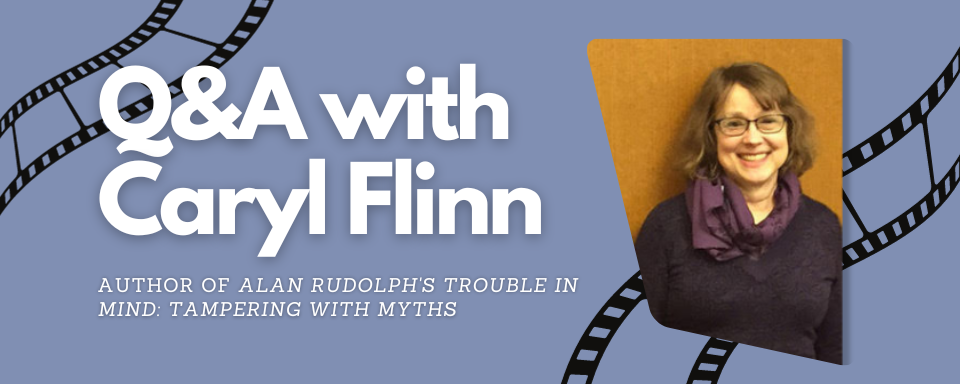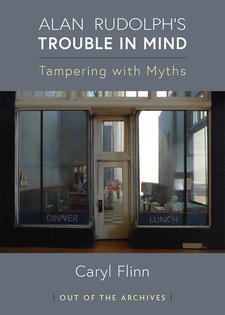Q&A with Caryl Flinn

This guest author post is a Q&A with Caryl Flinn, author of the new book Alan Rudolph's Trouble in Mind: Tampering with Myths, from the University of Michigan Press. The book is available in paperback and open access ebook.
Alan Rudolph is often remembered for being Robert Altman’s protégé rather than for his own career. How did you get interested in studying Alan Rudolph?
Rudolph’s films—especially Trouble in Mind, Mrs. Parker, and Choose Me—resonated deeply with me as my identity as an inveterate film lover was solidifying. His work had an edge, sense of humor, and sense of formal adventure (the colors, the music) that I found in only a handful of other directors, such as Nicholas Roeg and Ken Russell. This was the unholy trinity of filmmakers whose work I’d always rush out to see. It’s not that I didn’t like Altman (M*A*S*H*, Short Cuts, Nashville, McCabe, and The Player are brilliant), but for me his movies had nothing to do with Rudolph’s. Rudolph’s cinema always spoke to me more and had resonances that I couldn’t always explain. I liked that.
Writing this book gave me the opportunity to revisit that fascination and, more importantly, shed a wider light on a director who, in my view, has not been given his due in the history of American independent cinema—or in global art cinema. I enjoyed being able to take a deep dive into such a terrific movie.
What kind of influence did Trouble in Mind have on American film?
Some of its impact was immediate. At the time of its release in the mid-1980s, Trouble in Mind met American culture at a number of major crossroads. In film circles, it took part in a heady wave of neo noir (Kris Kristofferson is outstanding as Rudolph’s beaten-down-but-still-hopeful noir ‘hero’) and, like a couple of other neo noirs—notably, Blade Runner—it was laced with dystopic futuristic edges (For Rudolph, Trouble’s temporal setting is “where the past meets the future, but not in the present”). Trouble has a slightly punk aesthetic that made it both of the time and ahead of it: casting Divine as the gangster villain was a stroke of genius, and Keith Carradine’s fall from grace was wildly, goofily, captured in a punk/glam rock/teddy boy bouffant and wild glitter boy makeup. Trouble also boasts one of the most memorable soundtracks I know, combining jazz and electronica (rare at the time), blues and, most pointedly, the beautiful ragged vocals of Marianne Faithfull. Moreover, a number of details seemed to speak—sometimes obliquely, sometimes not—to Ronald Reagan’s policies and the rise of neoliberalism at the time, even as the film contains generous slivers of hope, never lapsing into full despair. Vincent Canby described Rudolph’s films as “fairy tales for adults.”
It may be slightly overstating its legacy, but to my mind, Trouble, like Chose Me the year before, helped initiate a cinematic period that took more visual risks, paid greater attention to music (especially by mixing genres and styles), and embraced quirkiness and mismatches that didn’t necessarily characterize independent cinema of the preceding 15 years. Things don’t always “add up” in a film like Trouble and, like the best of Rudolph’s other work, it moved away from narrative and dialogue and used visual and sonic details to connect with audiences, bringing them emotionally on board into its fantasy world. In this way, Trouble helped open the door for any number of filmmakers—a recent commentator mentions Wong Kar-wai. It also sustained the ongoing fascination with film noir, and addressed the impact of neoliberalism in the US and abroad.
Your book is the first in our new Out of the Archives series, which publishes short books that create new knowledge from archival materials in the Screen Arts Mavericks and Makers Collections at the University of Michigan Special Collections Research Center. What was your experience of working with the archive?
It’s both exciting and a little daunting that Trouble is the inaugural volume of the Out of the Archives series. The University of Michigan Library’s “Mavericks and Makers” has always been a very special collection for me personally. And, since my arrival in Ann Arbor in 2012, I’ve watched as it has grown into a first-rate center for students and researchers from around the globe.
In 1995, academics introduced the phrase “archive fever,” a term that scholars quickly (indeed, feverishly) over-used. But however worn down the words have become, there is a sense of exhilaration that I experience when doing archival work. Unexpected discoveries appear at every corner (Trouble, I learned, had no less a fan than Bob Dylan), and going through letters, reviews, script drafts, and other materials that the creators had themselves touched is a moving experience. The archival experience has been enhanced by a series of colloquia that the Library has organized over the years, celebrating the openings of holdings of creators like Rudolph. Additional colloquia have been held for John Sayles, Orson Welles, Nancy Savoca, Ira Deutchman and Robert Altman—all film “mavericks” whose works UM holds.
Do you have any tips for authors who want to embark on their own archival research project?
First and foremost is to learn as much as possible about the archive ahead of time: the nature of the collection, how it’s organized, how to access and reserve materials, when facilities can be utilized, policies concerning computers, cameras, and photocopying, if the archive controls publishing and reproduction rights to its materials, etc. And then—jump in!
Be prepared that your research questions may or may not be answered or supported by the materials you discover. In fact, materials often conjure up new or entirely different arguments and research directions. They can articulate connections that you may have never anticipated—even what’s missing can speak volumes. So you need to be open to discovery.
More pragmatically, be prepared for how long it can take to go through archival materials. Getting copies of documents for later viewing can help in that regard (if permitted) but be sure that you’re getting high quality resolution in those copies, especially if you’re relying on your phone. And a final tip: archival institutions sometimes have funds for researchers to help defray research and travel costs. Michigan’s Mavericks and Makers Collection has the Hugh Cohen Research Fellowship, for instance, developed with that assistance specifically in mind.
What do you hope readers will take away from Alan Rudolph’s Trouble in Mind?
As part of a series on archives, I hope that it shows the value of doing archival work. But my main hope for this volume more particularly, as I mentioned, is to give this amazing film and director a second look, and, ultimately, a larger place in the historical record. Rudolph certainly merits more attention than he’s received and, as I acknowledge in the book—and you do, in your first question—his career has often been overshadowed by that of Altman, the film giant from whom he got his start.
In a way, this reconsideration is already beginning. Rudolph and his films have online fan clubs, and blogs have featured some well-considered pieces on his career—although Remember My Name and Chose Me tend to be singled out more often than Trouble, which I think is his most accomplished work. I get the sense that he’s being rediscovered by an entirely new generation.
A few years ago, a retrospective of Rudolph’s work was held in New York City, and in October 2023, the American Cinematheque mounted a few of his films, including Trouble in Mind, in Los Angeles. Ann Arbor has played a supporting role in this renaissance: when in town for the Special Collections Colloquium opening his archive, Rudolph (and producer Carolyn Pfeiffer) took part in a Q&A after some screenings at the Michigan Theatre. It’s been nice to be living in a town and working at a university where Alan Rudolph has left so much of a mark and legacy.



